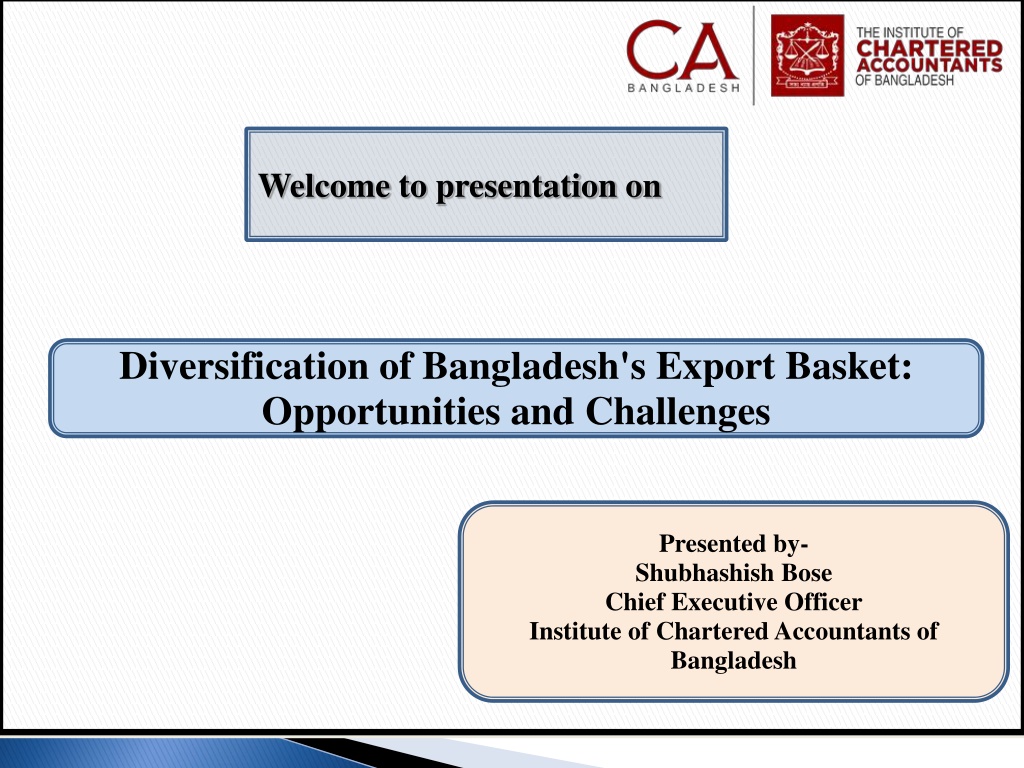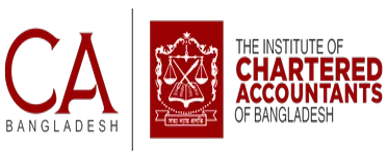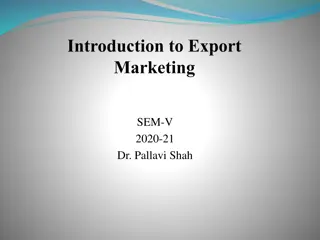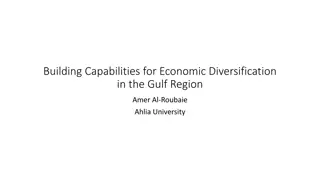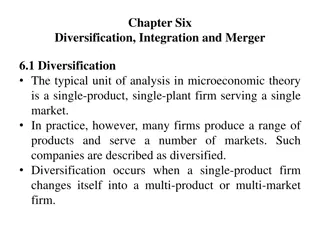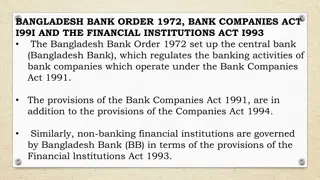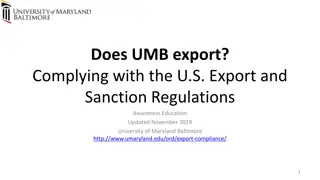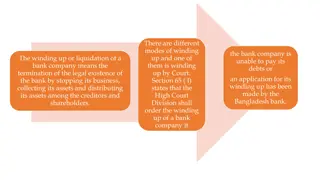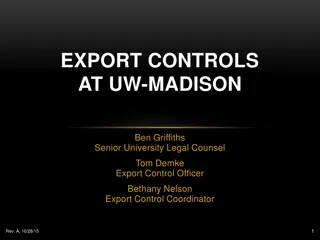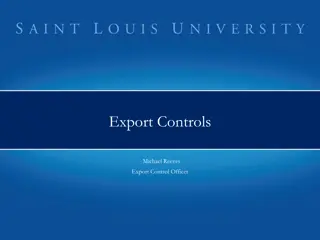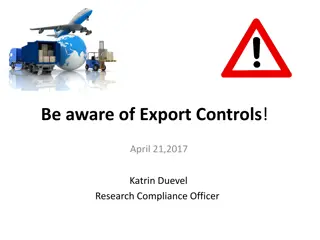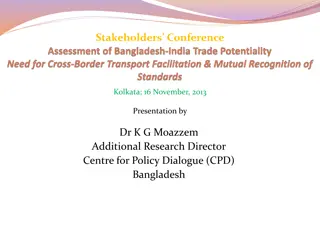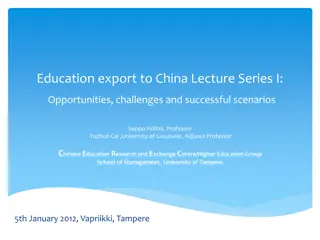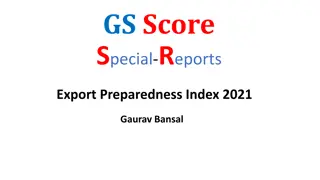Diversification of Bangladesh's Export Basket: Opportunities and Challenges
Bangladesh, an export-driven economy, has witnessed a shift from an agrarian to an export-focused economy. The presentation highlights the country's export policies, historical development, and collaborations driving diversification. It emphasizes the need for establishing intermediate industries to support growth and competitiveness.
Download Presentation

Please find below an Image/Link to download the presentation.
The content on the website is provided AS IS for your information and personal use only. It may not be sold, licensed, or shared on other websites without obtaining consent from the author. Download presentation by click this link. If you encounter any issues during the download, it is possible that the publisher has removed the file from their server.
E N D
Presentation Transcript
Welcome to presentation on Diversification of Bangladesh's Export Basket: Opportunities and Challenges Presented by- Shubhashish Bose Chief Executive Officer Institute of Chartered Accountants of Bangladesh
Name : The Peoples Republic of Bangladesh Capital : Dhaka Location : South Asia (20 34 - 26 38 ) N La. 88 01'- 92 42 E Long Borders : India on the east, west and north ; on the south side lies the Bay of Bengal and a small border strip with Myanmar on the south-east. Area/Land : 147,570 square km. Population : 166.50 million (2019) Estimated GDP : US$ 333.89 billion US$ (2019-2020) GDP per capita : 2,064 US$ (2019-2020) Annual Export : US$ 39.76 billion (2019-20) Annual Import : US$ 55.63 billion (2019-20) 2
The export policy for the period 2018-2021. product diversification market diversification availing of China situation
Background on the development of Export Bangladesh is currently considered an export-driven economy. Before its independence and even long time after independence, Bangladesh used to be treated an agrarian economy as the agricultural sector contributed the most to the Gross National Product of the country. However, scenario has now changed and the contribution of the agri sector has declined to 15.5% .The development of the export sector of the country could be attributed to the following: 1. The Multi Fiber Arrangement from 1974 through 1994; 2. The Agreement on Textile and Clothing from 1995 through 2005; 3.World Trade Organization s role in favour of LDCs; 4. Three Stage, Two Stage and Single Stage transformation for RMG provided by the Developed countries
Continued Continued 5. Joint Collaboration between Daewoo of Korea and Desh Garments of Bangladesh in training and installation of new machinery; 6. Generalized Systems of Preferences, Certificate of Origins and other preferential benefits; 7. Bonded Ware House facility provided by the Govt; 8. The Foreign Private Investment (Promotion and Protection) Act 1980; 9. Establishment of BEPZA; 10. Imposition of zero import duty on import of machinery for Export-oriented Manufacturing Companies; 11. Back-to-back LC facilities; 12. Introduction of Export Development Fund.
Continued Continued There is a huge scope for establishing intermediate industries supporting to big companies wherein parts of machinery, equipment, accessories, part-products could be manufactured. Thailand, Vietnam, Indonesia are examples in this regard. With the establishment of intermediate industries, we would be able to see a spill-over effect on the economy of Bangladesh. It would be possible because of the competitive edges that we are enjoying now. Apart from ready made garments, there could be intra sectors like undergarments, accessories, labels, hats, socks, stockings, scarfs etc.
Factors for Export Competitiveness: : Labour intensive industry; Low cost of skilled labour; Demographic dividend; Availability of gas, coal, water and fertile land; Adaptable workforce; Homogeneous population; Satisfaction level of workers; Strategic location of the country-bridge between SAARC & ASEAN;
Continued Enterprising investors; Diversification of products & services; Diversification of markets; Ethnic market for 8.6 million people; Huge domestic market; Duty free and quota free market access for Bangladeshi products (GSP, China CO, SAFTA, SAPTA, APTA, Chile CO, Annex III); Bangladesh is currently enjoying DFQF facility from 53 countries all over the world.
Trend in Export Trade Where we were ? Where we are now ?
Trend in Export Trade (Product & market wise) 1972-73 2019-20 % change No. of Products 25 730 (H.S. Code 4 digit) 2920% No. of Markets 68 201 295% 348.00 Mln.US$ Export value (goods & services) 39755.27 Mln. US$ 11423%
: Nati National Export Earning of Bangladesh From Goods & Service onal Export Earning of Bangladesh From Goods & Service 50000 47027.72 45000 41254.48 40535.04 39755.27 40000 38500.55 37752.08 36668.17 34846.84 34419.79 34257.18 35000 33674.09 33430.5 31208.94 30186.62 29963.66 30000 In Mn US$ 27027.36 25000 20000 15000 10000 6492.68 6081.18 4586.31 3653.71 5000 3494.9 3243.88 2936.3 3210.85 0 SERVICE GOODS TOTAL
Trend in Export Trade (value in mill US$) FY Export Target 30500.00 Export earning 30186.62 2013-2014 33200.00 31208.94 2014-2015 33500.00 34257.18 2015-2016 37000.00 34655.90 2016-2017 37500.00 36668.17 2017-2018 39000.00 40535.04 2018-2019 45500.00 33674.09 2019-2020
Export trends from 1972-73 to 2019-2020 Export earning (value in mill. US$) FY 1972-1973 348.41 1982-1983 443.43 1992-1993 1725.82 2002-2003 6548.44 2013-2014 30186.80 2019-2020 33674.09
(Value in million US$) FY Exports Growth in % 22928.22 24301.90 27027.36 (+) 41.49% (+) 5.99% (+) 11.22% 2010-2011 2011-2012 2012-2013 30186.62 (+) 11.69% 2013-2014 31208.94 (+) 3.39% 2014-2015 34257.18 (+) 9.77% 2015-2016 34655.90 (+) 1.72% 2016-2017 36668.17 (+) 5.81% 2017-2018 40535.04 (+) 10.55% 2018-2019 33674.09 (-) 16.93% 2019-2020 Average Export Growth for the last 10 years was 11.85%
Export from Bangladesh 1972-73 to 2019-20 45000 40000 35000 30000 Mn US$ 25000 20000 15000 10000 5000 0 72-73 74-75 76-77 78-79 80-81 82-83 84-85 86-87 88-89 90-91 92-93 94-95 96-97 98-99 00-01 02-03 04-05 06-07 08-09 10-11 12-13 14-15 16-17 18-19 FY
Export-Import Balance of Trade (Value in million US$) FY Exports Imports Balance 24301 35516 (-) 11215 2011-2012 27027 33969 (-) 6942 2012-2013 2013-2014 30186 40692 (-) 10506 2014-2015 31209 40638 (-) 9429 2015-2016 34257 34655 40036 (-) 5779 2016-2017 43663 (-) 8816 36668 2017-2018 52939 (-) 16271 40535 2018-2019 (-) 15421 55956 33674 2019-2020 (-) 15025 48699
Export, Import & Balance of Trade of Bangladesh 60000 50000 40000 30000 In Mn US$ 20000 10000 0 -10000 -20000 EXPORT IMPORT BALANCE
Shares of the Major Exportable during 2019-2020 01. Woven garments 41.70% 02. Knit garments 41.30% Leather & leather products 03. 2.37% Six Items constitute 91.90% of the total export figure . 2.62% 04. Jute & jute Goods 05. Agricultural products 2.56% 06. Frozen foods 1.35% Total: 92.34%
Bangladesh Export by Major Products during 2019-2020 Chemical Products 0.59% Plastic Products 0.30% Engg. Products 0.87% Leather & Leather Prod. 2.37% Footwear (Excl. Leather) 0.82% Other Products 3.26% Agri. Products 2.56% Frozen Food 1.35% Woven Garments 41.70% Home Textile 2.25% Jute & Jute Goods 2.62% Knitwear 41.30%
Export Performance of Service Sector FY 2019-20 Goods Procured in ports by carriers Goods sold under merchanting Manufacturing Services on Physical inputs owned by Maintenance and repair services Transportation Travel Construction ervices Insurance Services Financial Services (other than insurance) Charges for the use of intellectual Property Telecommunication and Information Services Other Business Services Personal, Cultural and Recreational Government goods and services
Regional Export Market Share (2019-2020) Bangladesh Exports to 201 Countries on the Globe. Region wise Shares are: European Region American Region Asian Region Middle-east region 2.23 % African region 0.82 % East European Region 2.93 % Oceania Region 2.28 % Other Region 1.68 % 55.53 % 22.02 % 12.51 %
Major Region Wise Export of Bangladesh During 2019-2020 Oceania Region 2.28% Other Countries 1.68% East European Region 2.93% African Region 0.82% Middle East Region 2.23% E.U Countries 55.53% Asian Region 12.51% American Region 22.02%
Major Exportables of Bangladesh RMG (Knit & Woven Garments); Home Textile; Pharmaceutical products; Agricultural products; Light Engineering products; Environment-friendly jute & jute goods; Footwear; Frozen foods (Fish & Shrimps); Leather and leather products; Furniture; Ocean going ship; Ceramic and porcelain wares.
Duty Free Countries for Bangladesh (more than 80% products of Bangladesh) Generalised System of Preference (GSP) Scheme: 27 countries of European Union, Australia, New Zealand, Norway, Switzerland and Liechtenstein are giving GSP facilities for all products except Arms & Ammunition (EBA scheme). UK is giving GSP facilities for all products except Arms & Ammunition (EBA scheme) Japan (except Arms & Ammunition and a hand leather gloves). Turkey (except RMG and Arms & Ammunition). Canada (except Poultry, Dairy, Egg, Arms & Ammunition). Russia (71 products). 24
Duty-free market access South Korea is giving us duty free market access on 4802 products. China is giving us duty free market access on 8256 products which covered 97% tariff line of China at 08 digit level. India is giving us duty free market access on all products under SAFTA (except Tobacco & Drugs). Other SAARC countries are giving us duty free market access on some products under SAFTA/SAPTA. Chile gave us duty free market access on all Bangladeshi products from 1st January, 2015. Belarus (71 products). 25
Strengths of Bangladesh Bangladesh is a market of 166.50 million people and 2.5 million people are joining the employment cycle every year; Bangladesh is largely a homogenous society with no major internal or external tension and a population with great resilience in the face of adversity; Natural endowment of Bangladesh includes gas, coal, water, other mineral resources and a very fertile soil; Possession of trainable, enthusiastic, hardworking and competent labour force suitable for any labour-intensive industry.
Continued Continued Geographic location of the country is ideal for global trades with very convenient access to international sea and air routes. Bangladesh is the bridge between ASEAN and SAARC nations; 73% of the population are at the age of 40 or below the age of 40 and hence it is a young population compared to other nations; Contributor to UNO peace keeping mission and supplier of Medicine to UNICEF; Bangladesh has started establishing three industrial hubs: Garment Village, Leather village and print hub. Bangladesh has never defaulted in its debt repayment, nor asked for their rescheduling; Bangladesh has outstanding records in human rights; Many International agencies have identified Bangladesh as one of the most promising locations for investments.
Continued Continued Eight Export Processing Zones already in operation; 10 Special zones are being established; 2 private Export Processing Zones are under process of development; Service sector contributes 49.5% to Gross Domestic Product; DFQF Market Access to major developed and developing countries of the world. Bangladesh is a member of D-8, OIC, SAARC, WTO and Commonwealth. The labour wage rate of Bangladesh lower than that in India, China, Vietnam, Cambodia and Thailand; Labour intensive sector is flourishing;
Challenges of Bangladesh Export Limited Products only six products constitute 91.90% of the total export income. Only RMG covers 80-83% of the export figure. Limited Market: The export of our products is concentrated mostly on two areas: European Union including the UK and the USA. The African Continent has the least market share for us. But a huge opportunity lies there. There are fourteen SADC countries in the continent. The SADC is a bloc, a common customs union which could be a gateway to 290 million people. If a product enters into a member-country, it can easily travel to other countries without facing customs problems. So efforts are necessary to conclude preferential trading agreement or free trade agreement with African countries. (1) EU 55.53% (2) U.S.A- 17.32%; (3) Other countries Export income from the African region stands at 0.82% of the total earning. 29
Way forward Product diversification Market Development 30
Product diversification Bangladesh (Export Policy 2018-2021)identified two categories of products: 1. Highest priority sector 2. Special development sector 3. Special Development Service Sector 31
EPF-Fund (Export Promotion Fund) There is a fund of Taka 210 million as EPF fund in the EPB. EPB recommends to the concerned bank for granting loan from this fund in favor of handicrafts exporters & ICT sectors. Limit for each handicrafts exporter is tk.5 lac. Limit for each ICT exporter is tk. 50 lac. 32
EDF Fund(Export Development Fund) To import raw materials for export business US$ 5.50 billion has been allocated to the Export Development Fund (EDF) This fund is operated by Bangladesh Bank The interest rate of EDF is 2% 33
Purposes of EDF To make the payment of import bill against Back to Back sight L/Cs. For export of goods, Bangladesh Bank arranges pre shipment credit by EDF; To increase the working capacity of Export administration and financial institutions; To encourage the foreign buyers of sourcing from Bangladesh. 34
RF (Refinancing Fund) There is a proposed fund amounting to Taka 500 crore as Refinancing scheme for export-oriented ship building industries. 35
How to enhance/boost export of Products & Services from Bangladesh Sending trade delegation to the unexplored /untapped markets like CIS, Latin America and African regions. Organising Sourcing Fair/Consumer fairs in Bangladesh; One District One Product ODOP Programe by EPB; Participation in exhibitions in other countries; Establishment of Permanent Fair Complex named Bangladesh China Friendship Exhibition Centre to promote domestic manufacturers to the foreign buyers. Participation in the World Expo namely: Shanghai, China-2010, Yeosu, South Korea-2012 and Milan, Italy-2015 to Project Bangladesh's potentiality in export business. Participation in the 6-month long Dubai Expo-2021 which starting from 1st October 2021. 36
Continued Continued Confidence level building for business people/ entrepreneurs; Containment of COVID-19 situation; Offer to conclude PTA ,FTA and CEPA; Shifting to ODM CETP; Foreign Direct Investment; Compliance Issue; (For example: Accord & Alliance) Green Factory; Public Diplomacy; Ethical Manufacturing; Removal of Mis- portrayal of Factories in Bangladesh; 37
Strengths of RMG Sector of Bangladesh Strengths of RMG Sector of Bangladesh Second largest cotton t-shirt exporter in the world after China; Second largest knitwear exporter of the world after China; Second largest Apparel exporter in the world after China; Bangladesh is the second largest denim exporter to the world; 6,500 garment factories in Bangladesh; 4 million workers are employed in Apparel sector; 80% of the workers are women; Workers are loyal, adaptable, trainable & committed; GSP facilities for the Apparel sector to EU, Japan, Australia, New Zealand, Canada; Duty Free Market Access to China, S. Korea, India. APTA scheme for China, S. Korea. SAPTA for India, Pakistan SAFTA for India
Continued Continued US$ 27.94 billion worth of Apparel export from Bangladesh; Available backward linkage Industry in the apparel sector; Maintaining compliance issues; Reputed world chain stores like Wal-Mart, C&A,H&M, Marks &Spencer, Zara, Mango, Matalon, GAP, Tesco, Puma, UNICLO are sourcing apparels from Bangladesh; High value added Apparel Production on the rise ;
Continued Continued Fashion University is producing a lot of Technical graduates with expertise in fashion every year who can contribute to the development high value-added products of the country; Own brands are developing in Bangladesh; Total Apparel trade in the world is 401 billion, but Bangladesh exports only 6.35% of the total trade; Positive growth in Knit & Woven Sector.
Strengths of Pharmaceutical Products Strengths of Pharmaceutical Products 246 companies registered with drug administration of Bangladesh; US$ 135.79 million worth of medicine export from Bangladesh; Export to 107 countries in the world; Quality & Price Competitive products; Maintain GMP (Good Manufacturing Practice); Second largest contributor to the National Exchequer ; Only successful LDC in the world to produce generic medicine; License to produce patent medicine; Good number of products registered with EU, Latin America & African Countries;
Continued Continued 97% of total domestic demand met from local production; 3% imported for domestic consumption; Multinational companies exist. 200 acres of land has been allocated for building API (Active Pharmaceutical Ingredients) park; Pharmaceutical companies can spend 30,000 US$ for registration to expand export. Trade delegation was sent to promote export to CIS & African countries;
Strengths of Ocean going Ship Building Industry Strengths of Ocean going Ship Building Industry Bangladesh is no longer a ship breaking country, it is now a ship building country; Capital as well as labour intensive industry; Emerged as an important exporting sector in Bangladesh; Bangladesh has the potential to earn US$2.0 billion by exporting ships and vessels in the next five years; Shipyards of Bangladesh are capable of making ships of about 10,000 DWT as per international standard;
Continued Continued Bangladesh has been exporting new ships to European Union market, especially to Denmark, Finland, Germany and to Pakistan, Mozambique, Singapore & Vietnam; The world demand of ship is worth 98.39 billion US$. The share of furniture is 3% of the total value of a particular ship. The furniture sector of Bangladesh is capable of supplying world class furniture to the ocean going ship industry of home and abroad. Ocean going Ship sector is using local furniture from Otobi, Navana & Tulip etc; 20% demand of the raw materials in the ship building sector (electric cable, screw & nutt, furniture & labour cost) is fulfilled by the local companies; Sufficient number of Engineers, Architects and Designers are available in Bangladesh;
Strengths of Strengths of Light Engineering Sector Light Engineering Products include Spare Parts of different industries, Bicycle, Motor cycles, Automotive maintenance free sealed batteries, Fancy light fittings, Construction equipments, Battery, Voltage stabilizer, Carbon rod, Automobile spares, Electronic items, etc; Bangladesh exports Light Engineering Products to E.U, USA, Middle East, Japan and India; Light engg. sector creates a strong base to expand assembling of the electronic sector; The European Commission has imposed a definitive anti-dumping duty of 48.50% on bi-cycles imported from China into EU member states. There is also a possibility of imposition of anti-circumvention duty on bike imports from Indonesia, Malaysia, Sri Lanka and Tunisia. Bangladesh can capture the Chinese market share in the EU member states in the near future. About 0.60 million workers are employed in this sector.
Strengths of Jute and Jute Goods Goods Jute is an environment-friendly product which is the best alternative to synthetic products such as carbon or ceramic fibers which are subject to environmental concerns; Bangladesh is the largest exporter of Jute and Jute Goods of the world; Environmental issues and awareness about synthetic fiber are potential opportunities for Bangladesh to expand business in jute & jute sector. Developed world is focusing on eco-friendly products and the demand for Jute goods is increasing. Jute is a natural fiber and biodegradable. Bangladesh is in a unique position to take advantage of this growing consumer concern.
Strengths of Frozen foods (Shrimps & Fish Strengths of Frozen foods (Shrimps & Fish) ) Supplier of world s reputed tasty, salty & fresh water Shrimps & Fishes; Strictly maintain quality following HACCP & Traceability; Exporter of Consumer packets and value added products; Approved processing plants by the EU are 74.
Strengths of Furniture Strengths of Bangladesh declared furniture as a priority sector for expanding export ; This sector is generating 1.7 million employment directly; 70,000 enterprises (both small and large scale) are supporting this cluster; Bangladesh Furniture & Interior D cor Expo has been being organised on regular basis since 2012 to attract foreign buyers; Exporting furniture to Japan, Singapore, Australia, USA and other markets; Furniture factories are committed to developing design and quality; Supplier to Shipbuilding Industry.
Strengths of Leather & Leather products (including footwear) Leather Sector (combining leather, leather products and shoe) is the 3rd largest exporting sector of Bangladesh; US$ 797.60 million export earning comes from this sector; More than 220 tanneries, 3500 medium SMEs and 110 large firms are involved in this sector; More than 7 million employments are generated, especially women are involved in this sector; ECO Friendly Leather Technology has been introduced; Bangladesh is in the spotlight for shoe due to the fact that western importers are looking for new sourcing destinations; Chrome free leather and Central Effluent Treatment Plant (CETP) technology implementation is under process; Due to quick domestic market expansion in China, the EU, USA & Japan are worried about future supply from China;
Strengths of IT Sector Bangladesh has been recognised the 26th best destination for IT out-sourcing globally by leading US company; Export earning has already crossed 6081.18 million US$ from ICT sector; More than 200 IT firms are directly and 800 IT firms are indirectly involved in this sector; More than 30 thousand employments are generated from this sector; Many developed countries are conducting their business in joint venture with Bangladeshi firms; English learning is developing in Bangladesh; This sector is totally free from compliance issues.
